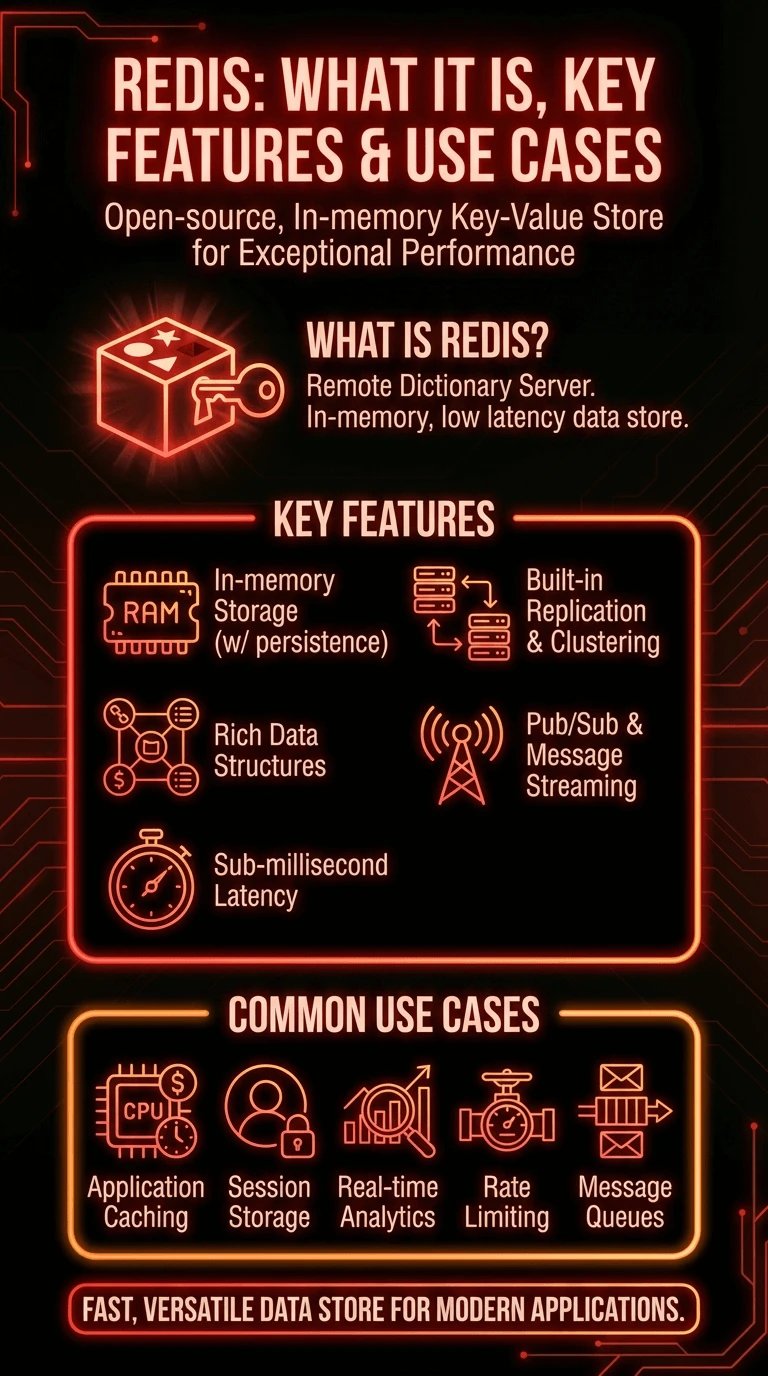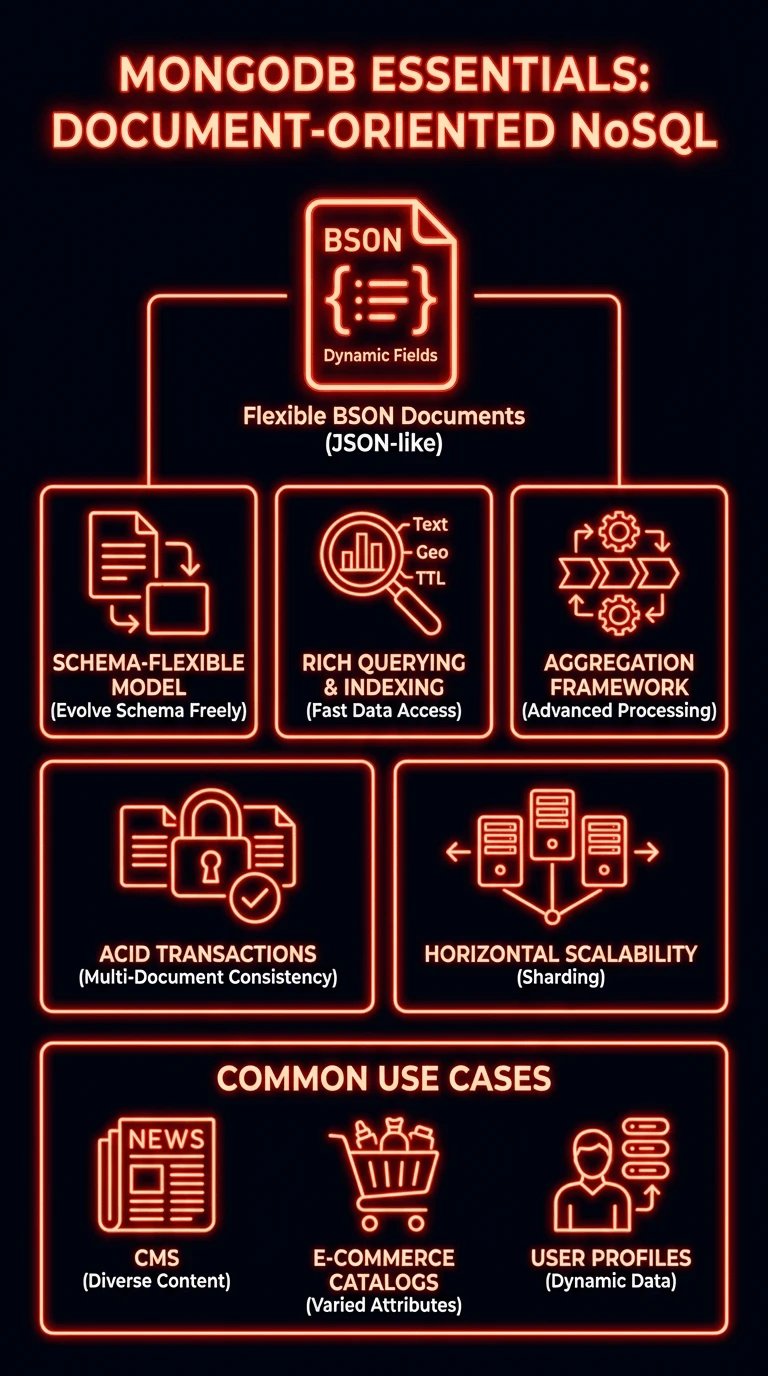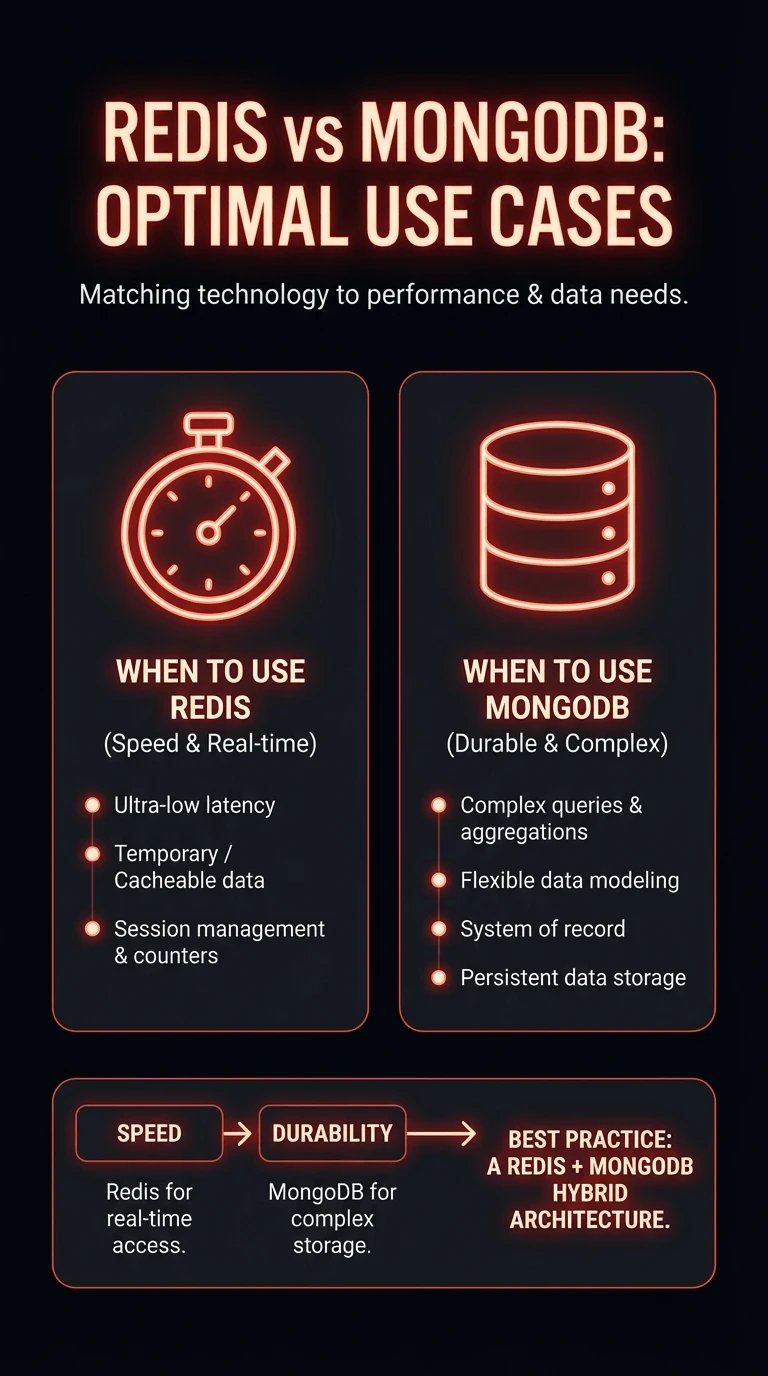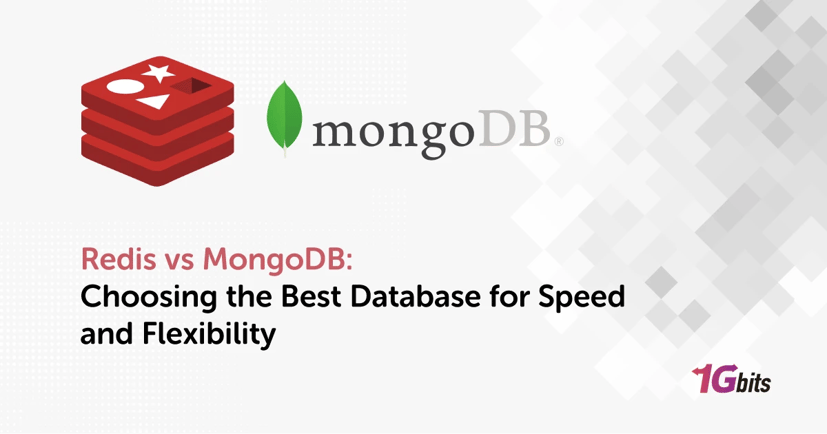Choosing the right data store is a critical architectural decision that directly affects performance, scalability, and long-term maintainability. Redis and MongoDB are frequently compared in modern application stacks, yet they are built to solve very different problems and are rarely interchangeable.
Redis is optimized for fast, in-memory data access, which makes it ideal for caching and real-time workloads. MongoDB, by contrast, is a document-oriented NoSQL database designed for durable storage, flexible data models, and complex querying. Understanding these fundamental differences is essential before committing to either technology.
Today's guide provides a deep, practical comparison of Redis vs MongoDB, helping developers, database architects, and CTOs decide which to use, when, why, and how.
What is Redis? Key Features and Use Cases
Redis (Remote Dictionary Server) is an open-source, in-memory key-value data store known for exceptional performance and low latency.

Key Features
-
In-memory data storage (with optional persistence)
-
Data structures: strings, lists, sets, sorted sets, streams
-
Sub-millisecond latency
-
Built-in replication and clustering
-
Pub/Sub and message streaming support
Common Use Cases
-
Application-level caching
-
Session storage
-
Real-time analytics
-
Rate limiting
-
Message queues
If you're interested in other in-memory/caching technologies, you may want to explore Redis Alternatives to compare Redis with similar options.
What is MongoDB? Key Features and Use Cases
MongoDB is a document-oriented NoSQL database that stores data in flexible, JSON-like BSON documents.

Key Features
-
Schema-flexible document model
MongoDB’s flexible schema allows each document within a collection to have its own structure. Fields can be added, removed, or modified at any time without requiring costly migration or downtime. This makes MongoDB ideal for applications where data models evolve frequently. -
Rich query language and powerful indexing
MongoDB offers a robust query language that supports filtering, sorting, projections, and complex conditions. It also includes: -
Single-field and compound indexes
-
Text search indexes
-
Geospatial indexes
-
TTL (Time-To-Live) indexes
-
These capabilities enable efficient querying and fast data access even as datasets grow to millions or billions of documents.
-
Aggregation framework
The aggregation framework allows developers to perform advanced data processing and analytics directly within the database. Using a pipeline-based approach, MongoDB can transform, group, filter, and compute data efficiently. -
ACID Transactions
MongoDB supports ACID-compliant transactions, including multi-document transactions across collections and databases. This ensures data integrity and consistency for use cases that require stronger transaction guarantees, such as financial operations or inventory management. -
Horizontal scalability with sharding
MongoDB is built for horizontal scaling through sharding, which distributes data across multiple servers. This architecture enables applications to scale seamlessly as data volume and traffic increase without sacrificing performance or availability.
Common Use Cases
-
Content management systems (CMS)
MongoDB's flexible schema is ideal for managing diverse content types such as articles, media assets, metadata, and user-generated content. -
Product catalog and e-commerce platforms
Product attributes often vary between items. MongoDB allows each product to have its own structure without enforcing a schema, simplifying catalog management. -
User profile and personalization
User data can grow and change over time. MongoDB supports dynamic user profiles, preferences, activity history, and personalization data, which eases management.
If you're planning to deploy MongoDB, you may wonder How to install MongoDB on Ubuntu. This step-by-step guide may help.
Core Differences Between Redis and MongoDB
Although Redis and MongoDB are both classified as NoSQL technologies, they are built for very different purposes.
Redis is designed for speed and simplicity through in-memory data processing, while MongoDB focuses on flexible data modeling and reliable long-term storage.
Understanding these core differences helps teams choose the right tool for the specific workload.
Data Models and Storage
Redis uses a key-value data model optimized for fast access to simple data structures, such as strings, hashes, and sets. This approach enables exceptional performance but limits how complex relationships can be represented.
On the other hand, MongoDB uses a document-based model, allowing nested and schema-flexible data structures. In terms of storage, Redis primarily operates in memory, while MongoDB stores data on disk and scales efficiently for larger databases.
Querying and Flexibility
Redis is optimized for direct key lookups, making it ideal for predictable access patterns. However, it does not support complex queries or joins.
MongoDB provides a rich query language with indexing and aggregation features, allowing developers to perform advanced filters and analytics as application requirements evolve.
Persistence and Durability
Redis supports persistence through snapshots and append-only logs, but durability is optional and often a lower priority to performance. This makes Redis suitable for transient or cacheable data. MongoDB builds a durable system of record, offering journaling and replication to protect data against failures and ensure long-term reliability.
Scalability and Replication
Redis scales horizontally using Redis Cluster, distributing data across nodes for high availability and fast reads.
MongoDB scales through sharding and replica sets, enabling automatic failover and consistent performance across large distributed datasets.
MongoDB is generally better suited for complex, write-heavy workloads, while Redis excels in low-latency, read-heavy scenarios.
Performance Comparison and Benchmarks
Performance is a key factor when comparing Redis and MongoDB, as each is optimized for different types of workloads. Redis achieves extremely low latency by storing data in memory, making it ideal for real-time and high-throughput scenarios. MongoDB, while slower for simple lookups, performs well for complex queries and persistent data operations.
Performance Benchmark Table (Typical Scenarios)
|
Metric/Scenario |
Redis |
MongoDB |
|
Average Read Latency |
~0.2-1ms |
~5-15 ms |
|
Average Write Latency |
~0.5-2 ms |
~5-20 ms |
|
Throughput (Ops/sec) |
Hundreds of thousands |
Tens of thousands |
|
Best Use Case |
Caching, sessions, counters |
Queries, analytics, storage |
|
Query Complexity |
Key-based only |
Rich queries and aggregations |
|
Data Persistence Cost |
Optional (lower overhead) |
Built-in (higher overhead) |
Note: Actual performance varies based on hardware, dataset size, indexing strategy, and deployment architecture.
If you're interested in performance trade-offs between caching engines, read Redis vs Memcached and Redis vs Hazelcast.
When to Use Redis vs MongoDB

The choice between Redis and MongoDB depends on your application's data access patterns and performance requirements. Each technology serves a distinct role and is often most effective when used together.
|
Requirement |
Use Redis |
Use MongoDB |
|
Ultra-low latency |
✅ |
❌ |
|
Temporary or cacheable data |
✅ |
❌ |
|
Session management and counters |
✅ |
❌ |
|
Complex queries & aggregations |
❌ |
✅ |
|
Flexible data modeling |
❌ |
✅ |
|
System of record |
❌ |
✅ |
|
Persistent data storage |
❌ |
✅ |
Quick Summary:
Use Redis for speed and real-time data access, and use MongoDB for durable storage and complex querying. For most scalable applications, a Redis + MongoDB hybrid architecture delivers the best balance of performance and reliability.
Understanding the Redis network is an important step for production setups. Check What is Redis port to avoid common configuration mistakes.
Combining Redis and MongoDB: Hybrid Architectures
In real-world systems, Redis and MongoDB are often used together:
An example architecture is to use MongoDB for a system of record (persistent data) and Redis for a cache layer where frequently accessed data is based.
The benefits of this approach are that it reduces database load and improves response time, leading to better scalability for your system. This pattern is widely used in e-commerce platforms, SaaS applications, and high-traffic APIs.
By combining Redis and MongoDB, teams benefit from improved scalability, better performance under load, and a clear separation of concerns.
Redis optimizes speed and responsiveness, while MongoDB ensures data consistency and durability; together, they form a balanced and resilient data architecture.
Deployment and Operational Insights
Redis is generally easy to deploy and operate, making it a popular choice for a simple setup and caching layers. It requires minimal configuration but demands careful memory management to avoid evictions and performance issues.
MongoDB involves more operational overhead, especially in distributed environments, using a replica set or sharding. In return, it provides strong reliability, built-in backups, and mature monitoring tools suited for long-term data management.
In practice, Redis fits best when simplicity and speed are priorities, while MongoDB is better suited for systems that require reliability, scalability, and persistent storage.
|
Aspect |
Redis |
MongoDB |
|
Backup |
Snapshots/AOF |
Native backups |
|
Monitoring |
Redis CLI, exporters |
MongoDB Atlas, Ops Manager |
|
Cloud Support |
AWS, GCP, Azure |
Native cloud integrations |
|
Complexity |
Low |
Moderate |
Conclusion
Redis and MongoDB are built for different purposes, and choosing the right one depends on how your application handles data. Redis delivers unmatched speed for real-time and cache-driven workloads, while MongoDB provides the durability, flexibility, and querying power required for long-term data storage. For most production systems, the smartest approach is not choosing between Redis or MongoDB; instead, combining them helps you reduce latency, scale efficiently, and maintain data reliability as traffic grows.
Ready to optimize your infrastructure? Evaluate your workload, identify performance bottlenecks, and design a data layer that balances speed and persistence. Explore Redis and MongoDB deployment guides, performance comparisons to build a faster, more resilient application stack.







